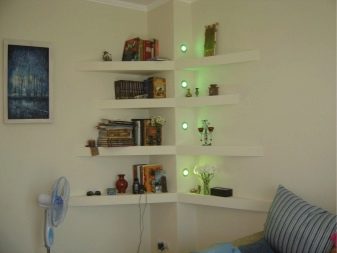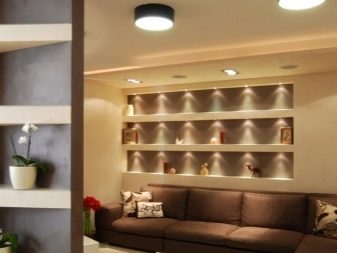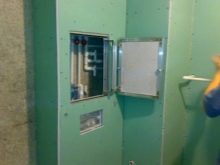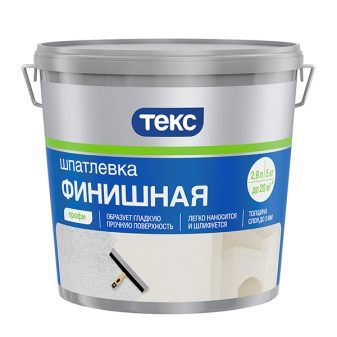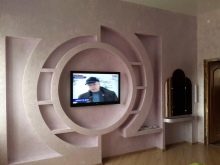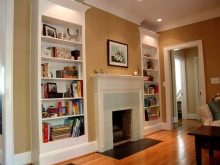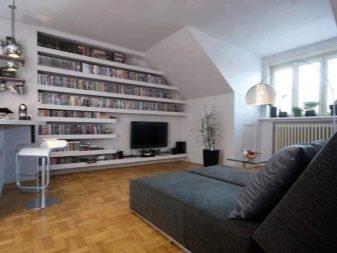Shelves made of plasterboard: types of designs
Drywall is widely used. They trim the walls and ceilings, hide flaws, from it erect various decorative structures. For example, mounted shelves, playing on the corners, window and door openings.
Consider the features and types of designs shelves.
Special features
Drywall - a very plastic material. This is a sheet with a base in the form of plastic gypsum, which is glued on both sides with construction cardboard. It is thick, it is wall, ceiling, arched. For shelves try to use more reliable material thickness, although it is often used and arched (if you need curly shapes). When heated, gypsum can bend.
It is easy to cut and assemble, which allows you to construct various design designs. This is especially true if the room does not have the usual rectangular shape.
Outstanding supporting columns, ventilation and heating pipes, walls with a step spoil the appearance, and cause difficulties with the arrangement of furniture. All this can be hidden under drywall.And so that the usable area is not lost, mount niches or shelves.
Advantages of shelves from GKL:
- masking communications;
- compatibility with built-in backlight;
- cost is lower compared to other materials for the manufacture of shelves;
- long service life;
- resistance to deformation;
- refractoriness;
- environmental friendliness.
There are also disadvantages. Gypsum shelves do not withstand serious loads. In this case, two plates are laid at once or wooden inserts with additional reinforcement are used. Be sure to erect a frame made of metal or wooden slats with their fastening to the wall. Drywall has no sound insulation.
The presence of shelves around the window openings and along the walls will not reduce the noise level. Designs made of plasterboards allow you to save on furniture (shelves, open shelves of other materials, side tables and TV tables). But there is a drawback. To move the structure, you will need to dismantle with subsequent repair work.
Kinds
All the shelves of drywall can be divided into two main groups: decorative and functional. The first often open, have a lightweight frame.They have various decorative elements of the interior (vases, souvenirs, photographs).
Functional shelves are more durable, have sufficient capacity. They are designed for heavy loads, can be closed or open. Often they are erected for a specific purpose, for example, as a pedestal or a niche for TV.
Shelves can be divided by their localization. Center located in the center of the room. Either the design is a bright accent of the interior, made of an ensemble of various shelves and niches. Products are wall, corner and embedded. The latter are the most convenient.. Their placement is especially appropriate in storerooms, closets, and niches in bathrooms.
Corner shelves are more durable than straight. If the wall is strongly curved, has outstanding structural elements, you can make a false-wall of drywall. So that the living space does not disappear, you can equip niches with shelves. They can also be decorative or functional.
Look beautiful with backlight. The configuration of the shelves can be linear or figured, subject to the overall style of the interior of a particular room.
Design
Drywall allows you to build structures of various shapes. The shelves themselves can be of any shape (even asymmetric and tilted). Everything is limited by the space of the room and the fantasy of the designer. GKL is often used to create built-in wardrobes and walls. This allows you to build a structure that will replace the furniture wall.
This furniture has its advantages:
- The size and number of shelves can be determined independently, taking into account the dimensions of the already existing equipment.
- You can bring sockets and lights.
- No need to spend time searching for a suitable furniture wall or slide, which can be more expensive in price than the materials of construction.
On the other hand, the shelves of plasterboard can not be moved or sold as furniture. In contrast to the TV cabinets with the use of shelves from the GCR are more functional. Additionally, wall or spotlights, LED lamps and ribbons can be installed.
The backlight looks beautiful, it is functional:
- additional lighting is created;
- using light, you can zone the space;
- in the absence of main illumination, cozy lighted islands are formed.
It is not always possible to find a suitable corner rack. This problem is perfectly solved shelves made of plasterboard. You can adjust their size and shape. Open shelves do not reduce the space of the room, organically fitting into the interior. Special attention is required plasterboard shelves under the book. Printed products weigh a lot, bookshelves must take into account increased load. Since the gypsum board is not as durable as wood, the shelves themselves should not be large. The maximum they are designed for 10 books.
If the house is multifunctional, for example, it is an open plan or a combination of rooms (bedroom and living room, kitchen and dining room), can be built from drywall zoning partitions with through the shelves. This allows space to be delimited. Shelves can be used for storage or to decorate with decorative vases. This option is relevant for studio apartments.
It is possible to make shelves from plasterboard around window and door openings. Near the window you can organize a podium with a niche for storage. When installing, you need to take into account the weight of the person, do not forget about the batteries located. If you do not put the ventilated lattice, the room during the cold period will be badly heated. Shelves can range from aperture to the wall or in the form of narrow canisters up to the ceiling.Above the doors you can organize a mezzanine, on which to place voluminous, but light objects.
The shelves do not have to be wide. They can accommodate a lot of useful things. If there is a desk near the window, shelves from a plasterboard will replace the rack and the closet. With them you can organize a comfortable workplace.
Communications can be hidden in a plasterboard box. If these are heating tubes, it is necessary to mount the ventilation grilles.. From the outside you can place several small decorative shelves.
If it is a drain pipe in the sanitary room, you can make an interesting cabinet. So it will look externally. Inside it should be spacious enough: you can hide mops and brushes near the pipe, install several narrow shelves for household chemicals.
A similar technique can be applied to the bathroom, performing a box with shelves and niches.
Scope of application
Shelves of drywall can be mounted in any room. However, it is necessary to take into account its humidity.
GKL does not like water and condensate, therefore for rooms with high humidity (bathroom or kitchen) it is better to use moisture-proof material.
- In the living room most often erected central structures in the entire wall. In them it is convenient to organize niches for TV, which is usually placed in the hall.
- Also, decorative designs are often erected in the children's roomto share the playing, sleeping and training areas. This is especially true if the room is shared by two children.
- In the kitchen usually place open shelves from GCR. They must be strengthened because the dishes are heavy.
- In the bathroom and toilet because of the limited space to pick up shelving and lockers is difficult enough. It is easier to solve the problem of organizing space with the help of constructions made of moisture-proof plasterboard.
- In the hallway and corridors most often have a closed multifunctional shelves. You can mount the mezzanine.
- In the bedroom any solutions are possible. Shelves can be exclusively decorative or functional. Much depends on the area and dimensions of the furniture.
Installation
The construction of any structure begins with the creation of a sketch, which is a type of shelf after installation. It is important to consider the appearance of the shelves, functionality, calculate the size and weight load.The design and appearance of the future structure is influenced by the size and appearance of the drywall. For example, for curvilinear execution is applied flexible arched plasterboard.
If a large load is planned on the shelves, then 2 sheets of material will have to be laid. May additionally require reinforcing elements. If GLA is more than 12 mm thick, a reinforced frame will be required.as the sheets weigh a lot.
If the shelves are purely decorative, you can take a material thickness of 6.5 and 9.5 mm. The standard width of drywall is 1.2 m, the length can vary up to 3-4 m.
If the shelves are planned long (more than 1 m), vertical lintels are recommended. Longer shelves may not withstand the load. If they are extremely decorative and narrow, you can do without jumpers. The facade and side parts of the structure can be finished with arched drywall. It is cheaper. On the strength of the structure will not affect, but it will save. It is interesting to look concave shelves, which are built from the arched GCR.
To work will require:
- screwdriver;
- construction knife;
- pencil;
- square, ruler;
- roulette;
- scissors for metal;
- perforator.
Materials:
- drywall;
- metal profile;
- frame hangers;
- dowel-nails;
- self-tapping screws or liquid nails.
For finishing you need:
- starting and finishing putty;
- putty knife;
- fine sandpaper;
- corners or mounting tape for the ends.
Installation begins with the construction of the frame of the metal profile, which is attached to the wall by dowel-nails.
If the construction is simple, you can use wooden slats. Where the load is planned, the frame is strengthened.
The next step is laying the backlight, if it is planned. All wires are hidden in a plastic corrugated box. After on the screws or liquid nails fasten drywall. The design is ready, you can proceed to the finish.
How to finish?
The finishing work is quite simple, you can do it yourself. The difficulty lies in finishing the butt edges. The material may crack in the future, start to crumble. To avoid this, the joints and the ends of the sheets are trimmed with aluminum and plastic corners.. Semicircular models can be trimmed with mounting tape. It is better not to save on it, you need to fix everything carefully.
Joints can be reinforced with a reinforcing mesh. It is pasted with fragments on top.Heads of self-tapping screws should not stick up, they are sealed with starting putty. After processing the joints and the ends of the entire structure put the finishing putty.
For its complete drying will take at least a day. After the material must be polished, for example, using fine sandpaper.
Drywall can be decorated with almost any decorative material. It can be wallpaper, plaster, various types of paints. The construction can be finished with the same material as the walls. Then the shelves will look part of the wall. You can highlight them with material and color to make a bright accent in the interior, visually divide or adjust the space.
If it is planned to paint the structure with colored paint, it is recommended to make the niche lighter.. It will be shaded anyway. To do this, you can dilute some of the paint from the white of the same brand. Alternatively, you can decorate individual shelves or structural elements. For finishing it is worth using stone, mirrors, stained glass or plastic, imitation of stained glass and much more.
Do not use heavy decorative elements.
The choice of decorative material can be approached from the practical side. Much depends on the frequency of cleaning. If the shelves are covered with wallpaper, they can quickly become unusable.. In this case, the external vertical surfaces can be covered with wallpaper to match the walls, and the horizontal shelves can be painted.
If the shelves are exclusively decorative, they will have to be infrequently cleaned with a vacuum cleaner or a special brush, they can be completely pasted over.
If you want to make shelves in the kitchen or in the bathroom, materials for decorative finishing should be chosen more practical, resistant to moisture and dirt.
For example, you can paint them with paint. Coloring can be chosen practical.
To learn how to make shelves of plasterboard in the bathroom, see the following video.
Beautiful examples in the interior
Finally, you can turn to examples showing the harmonious combination of drywall shelves with the overall concept of interior style.
- From the plasterboard you can make a niche for TV and technology, to mount a whole ensemble of shelves, which will replace the furniture wall.
- You can create interesting designs of non-standard shapes, for example, with smooth, semi-circular bends, kinks, geometric shapes, and inclined shelves.
- Shelves can be located not only along the walls. For dividing the space, it is better to install decorative plasterboard partitions with through shelves.
- Shelves often act as an original design solution, while retaining their functionality.
- If the wall has niches or outstanding elements of the building structure, you can beat them. If a part of the wall with a fireplace is given forward, it is worth filling the formed niches with shelves.
- Unusual low ceiling, other forms of rooms complicate the choice of furniture. Shelves and cabinets can be made of plasterboard.
- In small apartments shelves can be placed around the door and window openings. Simple and functional.

